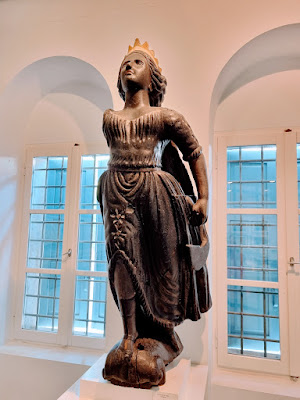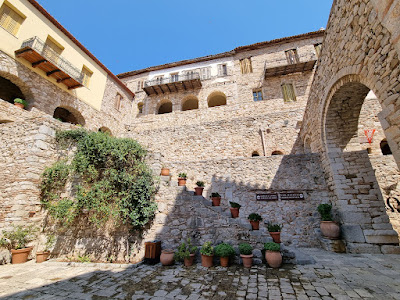When we walked around the Temple of Posiedon earlier in the month, pausing to consider the importance in history of just a few pillars reaching into the sky, I felt we had come to a "best of" experience of some sort. Little did I expect that in the next few days, we would explore an even more important historical site, and another place of great beauty.
We emerged from the stillness and serenity of the Corinth Canal into a new stretch of water with cool winds blowing straight on the nose. I stood face up, arms stretched out joyfully emulating Kate Winslet , anticpating a day of tacking (zigzagging) up the Gulf of Corinth towards our next stop. At last, some proper winds to sail with, the future was so shiney!
Of course, this was only a temporary effect of the narrowing headland that was now behind us, and in fact the wind died to 2 knots coming from behind us. As we were motoring at 6.5knots, this meant no cool breeze at all, and periodically Mike would tire of my sighing and panting, and we would turn everything off and jump into the blue to cool down. I hate the heating up part, but it is such bliss to be able to stop at any time, just you, your boat and clear calm water. Of yes, and some dolphins too if you happen to look at the right time.
We were heading to Galaxidi/Galaxidhi on the northern side of the Gulf, 38nm from the canal exit. As we travelled up the gulf we headed for one of two large bays, Itea Bay, then turned left around an small islet into the beautiful cove facing Galaxidi. While we chose to anchor to make the most of any breezes that may pass our way, Galaxidi is one of the rare places where tying stern-to on the town wall is a enticing prospect. Indeed we found three of the boats already there were friends, or friend of friends (which in our new world amounts to the same thing) - SV Impavidus, SV Chill and SV Eriskay - already enjoying this picturesque village.
 |
| The view while at anchor near Galaxidi |
Galaxidi feels like an island oasis, but is actually on the Greek mainland, about 3hours drive from Athens (in case you are inspired to go...). When we weren't escaping the heat drinking gin in SV Chill's air-conditioned cabin, or on a day trip in a cool car, we wandered around the town admiring old ship captain's houses or visiting the bakery in the Agora, the town square. Like all things Greek, Galaxidi has a rich history dating from something-something BC, but is more recently known for it's excellent boat building, a reputation established in the 1800s and lasting until the beginning of the 20th century. Galaxdi has a modern maritime musuem tucked inside one of the old buildings hidden up a lane. It is the oldest martitime musuem in Greece, and the collections of documents, artwork, figureheads, weapons, coins, maps etc cover the history of the town and local people for 5000 years. The vast collection of artwork, apart from being beautiful to look at, tells us how far the ships built in Galaxidi travelled, what trade routes they took, what was transported and what happened in ship wrecks.
 |
| Figurehead in the Museum: when a captain died, his widow would paint his ship's figurehead black |
For more information on their collection, and the role the town's ships had in the Greek War of Independence, see Galaxidi Museum .
As much as we could have spent days pottering about the town, and coming to know it far better than we did, we chose to venture out a bit further by car. On our first day, Ant and Cid from SV Impavidus joined us as we set out for THE most important historical site for ALL MANKIND! I'm only slightly exaggerating. It was lucky Mike had had a few days break from me mentioning archeological sites, as he could have been forgiven had he shuddered when I suggested we visit the Archeological Site, and Museum, of Delphi. Just a short half hour drive away, past valleys, bays and the olive grove of Amfissa, over 3000 years old, covering 55 acres with over 1 million olive trees. Then up, up into the hills of Mount Parnassus, to the stupendous, incredible place that once was once considered to be the very centre of the world.
The site contains two sanctuaries, that of Apollo (5th century BC), and of Athena Pronaia (7th to 4th century BC), not to mention the route of the Sacred Way. The site is outstanding, with breathtaking views down the steep hillsides, and ancient, towering edifices above and around you. Also placed around the site were other structures, including one stone carved object that looked like the stone tip of a torpedo. Hmm, I thought quickly and passed it by. Turns out I was looking at a simplified copy of the Omphalos of Delphi. Legend has it that Zeus released two eagles from opposite ends of the world, and when the two birds crossed paths, Zeus declared that the site, Delphi, was the centre of the world. A stone, or Omphalos, was placed in a tripod on a column supported by three dancers, to mark the spot. The original stone is inside the museum; this one is very prettily decorated wth carvings representing the wool cover and precious stones in the shape of a mermaid and 2 eagles, that used to protect the Omphalos.
 |
| Mike, Cid and Ant climbing up and up.... |
And you may have heard of the Oracle of Delphi, the most important oracle particularly in the 8th-4th centuries BC, who delivered oracles from Apollo. Pythia, as she/shes were known, first belonged to the Mother Earth, Gaia, but was stolen by Apollo. His (or her?) advice was sought by kings and lawmakers, to decide when to plant, or when to go to war, or... thus she was very influential. However, one had to be very careful what you asked, as her reply was often ambiguous and open to interpretation - the wrong one could land you or your people in trouble. As to how she received the words of Apollo? Apparently she had smoke blown up her ... arse. To quote Britannica:
"Consultations were normally restricted to the seventh day of the Delphic month, Apollo’s birthday, and were at first banned during the three winter months when Apollo was believed to be visiting the Hyperboreans in the north, though Dionysus later took Apollo’s place at Delphi during that time. According to the usual procedure, sponsors were necessary, as was the provision of a pelanos (ritual cake) and a sacrificial beast that conformed to rigid physical standards. The Pythia and her consultants first bathed in the Castalian spring; afterward, the Pythia drank from the sacred spring Cassotis and then entered the temple. There she apparently descended into a basement cell, mounted a sacred tripod, and chewed leaves of the laurel, Apollo’s sacred tree. The Pythia often went into an ecstatic state and would channel Apollo. Some have claimed that her altered condition was the result of gases—such as ethylene and methane—that were emitted from geologic fault lines underneath the temple. Whatever the cause, the Pythia would speak, intelligibly or otherwise."
Although this does sound all a bit dodgy, there were three Delphic Maxims inscribed into the front of the Temple of Apollo that are still relevant today: Know Thy Self, Nothing to Excess, and, Surety Brings Ruin.
After sufficiently heating up, and eyeing off the impressive sprinkler system around the site to protect the relics from bushfires, we stepped over Huuuuuuuuge dogs- slash- wolves that had worked out the coolest place to be was right in the doorway under the airconditioning units in the cafe, and made our way to the Museum. Again, mindblowing. Hundreds of sculptures and relics, rescued and restored, are now displayed undercover, away from the elements. Among the most famous exhibits are the Sphinx of Naxos, and, The Charioteer of Delphi. Carrved from marble in 6th century BC, the Sphinx was a gift from the people of Naxos, an island we had visited in the Docadonese weeks before. This gift accorded Naxions the promanteia, or privilege, to have priority in receiving oracles. The Sphinx was originally mounted on a tall 12m column at the centre of the Temple of Apollo.
 |
| Intricate detail in this statue of a running woman |
 |
| Decorations left over from the Feast of the Dormition of the Virgin Mary |
 |
| Entrance to the smaller church |
 |
| I love a cool crypt |
 |
| Saint Alison in the Crypt |
 |
| Detail inside the crypt, close to the oldest parts of the site |
 |
| Golden mosiac tiles and iconography adorn the ceilings |





























No comments:
Post a Comment